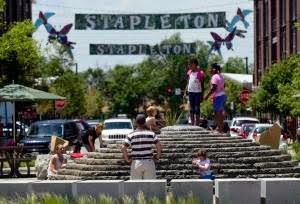So after one week of 80238 and our post on how Stapleton is in the top 1% of zip codes in income and education levels, I am proud to say that we have received close to 1,000 hits, but was disappointed that I only received two comments. However, of the two I did receive one from Christopher Gramkow caught my attention when he asked:
While the comment may have been tongue in cheek, it absolutely is a question that many in Stapleton have asked. In fact, many in the neighborhood are beside themselves that plans for the new Eastbridge Town Center include a second King Soopers, rather than an upscale grocery like Whole Foods or a specialty grocery like Trader Joe's.
Conversely, about a year ago if you took a stroll along 26th avenue, east of Westerly Creek and looked south you saw the old fence that divided Aurora and the airport with a sign asking a very different question:
To help illustrate that point, let's go back to the Washington Post's Super Zip analysis and take a look at the zipcode on the other side of that fence - 80010.
You read it right, 80010 is in the bottom 10% of zipcodes in the nation with regard to education and income level. Median income in 80010 is over $90K lower than 80238 and only 10% of adults have a college education. While 80010 is an extreme example, the contrast with the bordering zips is still stark:
Percentile
Zipcode Income and Education Median Income % Adults w/ College Degrees
80238 99% $122,817 78%
80110 7% $31,248 10%
80110 7% $31,248 10%
80239 23% $44,597 12%
80216 10% $31,073 12%
80207 51% $51,347 39%
80220 81% $63,207 58%
The closest in percentile rank, 80220, has almost half the median income and 20% lower college degree rates than 80238, say nothing of the contrast with the other zips. It is hard to argue with the statement that Stapleton is highly isolated from its neighbors, but as I said, it may be the most isolated zip among the top 1% of zips in the nation.
For comparison sake, let's look at another super zip in the heart of the south, Birmingham, AL and zipcode 35223 where the income and education level are similar to Stapleton, placing it within the top 1%:
In Birmingham, the income and education levels in adjoining zipcodes to superzip 35223 are nowhere near as different as Stapleton and its neighbors:
Percentile
Zipcode Income and Education Median Income % Adults w/College Degrees
35223 99% $133,328 79%
35213 96% $94,302 76%
35213 96% $94,302 76%
35205 44% $32,881 41%
35209 65% $47,544 51%
35216 70% $52,097 52%
35243 88% $71,779 66%
35242 93% $93,039 59%
35210 56% $53,136 28%
In Alabama, one of the poorest states in our nation, the one and only 1% superzip has bordering zipcodes that are not much different than itself. There is no question that there is severe poverty in Birmingham, but the people in 35223 don't see the contrast we see in the bordering neighborhoods of 80238.
I looked at other top 1% zipcodes in Minneapolis, St. Louis, New Jersey, Houston, etc. and none had as sharp a drop in incomes and education immediately outside its borders than 80238.
So, when we ask the question why we don't have a Whole Foods? It is probably because no one other than 80238ers can afford to shop there, making a Whole Foods in our neighborhood nonviable. Likewise, when we ask why the fence is still up between 80238 and 80010? Maybe it's because we feel more comfortable with it there.
If the goal of the Green Book was to tear down fences and build a vibrant economy for Northeast Denver, we have to ask whether we are doing enough to that end. Is it possible that the increasing economic vitality of our surrounding neighborhoods is in 80238's interest? Or do we believe that we need to build more fences to protect us from our neighbors?
80238 will begin to explore what we have done and are doing to realize the goal in the Green Book of an integrated community and what that might mean for Stapleton and Northeast Denver.
I encourage everyone who reads 80238 to chime in with your thoughts and comments. I have removed the requirement that people register before commenting on the site in an effort to promote discussion. So please tell me what you think and what other issues we should examine. You can follow the blog on Facebook at: https://www.facebook.com/80238blog or on Twitter @80238blog.
. . .In case you were wondering, the 35223 zip in Birmingham, technically does not have a Whole Foods- but you can find one just down the road in 35243 in the Cahaba Village Plaza.
I encourage everyone who reads 80238 to chime in with your thoughts and comments. I have removed the requirement that people register before commenting on the site in an effort to promote discussion. So please tell me what you think and what other issues we should examine. You can follow the blog on Facebook at: https://www.facebook.com/80238blog or on Twitter @80238blog.
. . .In case you were wondering, the 35223 zip in Birmingham, technically does not have a Whole Foods- but you can find one just down the road in 35243 in the Cahaba Village Plaza.





